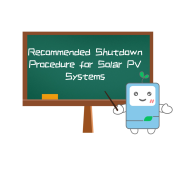Recommended Shutdown Procedure for Solar PV Systems
Properly shutting down a solar PV system is a common concern among users. Within the entire system, the AC side can be disconnected via the NFB (no-fuse breaker) on the AC distribution panel. The DC side can be disconnected either via the DC switch on the solar PV inverter or through the DC junction box, which provides two disconnection methods: a DC switch and a DC fuse. The disconnection process involves grid synchronization and handling the high voltage from the PV modules. Therefore, the sequence of operations is critically important.

Fig. | Solar PV System Architecture
Safety is the foremost consideration, with arc management being particularly critical. A key characteristic of DC arcs is that both voltage and current remain consistently positive. Once an arc forms during disconnection, extinguishing it becomes challenging. Since solar panels are current sources that continuously supply current during the disconnection process, there is a potential for DC arcs to form, posing fire risks.
The direction and magnitude of AC arc current fluctuate with the time cycle, causing the arc to naturally extinguish and reignite within each cycle. Due to its zero-crossing characteristic, a standard circuit breaker can effectively extinguish AC arcs.

Fig. | Arc Discharge
Considering arc safety factors, the following are recommendations for shutdown operations:
Proper Preparation: Before initiating the system shutdown, ensure you have the following items on hand: a fire extinguisher, heat-resistant gloves, a DC current clamp meter, and pliers.
Recommended Shutdown Procedure:
- Use the shutdown feature on the machine or through the monitoring system to perform the shutdown operation. Shutting down the inverter will prevent backflow to the grid, ensuring grid stability and personnel safety.
- Disconnect the breaker on the AC distribution panel to sever the electrical connection between the inverter and the power grid, ensuring that the system is completely powered down.
(*Considering the potential for short-circuit currents from the solar panels due to damaged wiring or equipment, use a DC current clamp meter to confirm that the current is zero before disconnecting the DC side. If DC current is still present, do not proceed with the disconnection and wait until sunset to perform the operation.)
- Disconnect the DC switch on the solar inverter.
- Disconnect the DC switch inside the DC junction box.
Precautions
As arcs are high-temperature and electrically charged phenomena, it is essential to maintain a safe distance. If an arc occurs during the DC switch disconnection process and you have isolation tools, such as heat-resistant gloves and pliers, use these tools to return the DC switch to the conductive position. This may extinguish the arc by re-establishing the connection. If a high-temperature arc has already caused the isolators to burn and spread, and a fire extinguisher cannot effectively extinguish the fire, use pliers to cut the wires at the source from the solar panels. This will cause the DC arc to disappear as the current drops to zero, thereby reducing the risk of the arc spreading.




